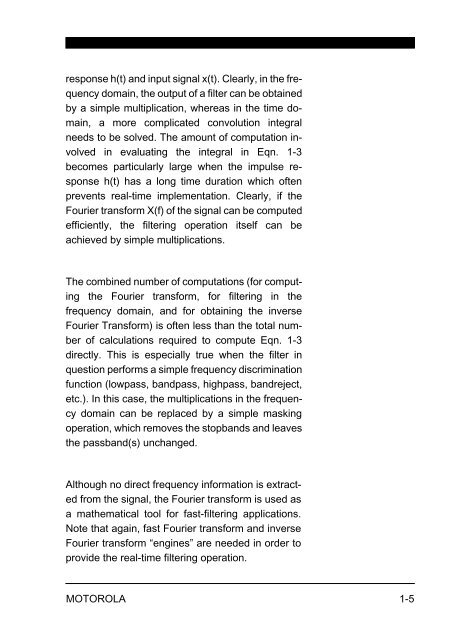Fast Fourier Transforms on Motorola's Digital Signal Processors
Fast Fourier Transforms on Motorola's Digital Signal Processors
Fast Fourier Transforms on Motorola's Digital Signal Processors
Create successful ePaper yourself
Turn your PDF publications into a flip-book with our unique Google optimized e-Paper software.
esp<strong>on</strong>se h(t) and input signal x(t). Clearly, in the frequency<br />
domain, the output of a filter can be obtained<br />
by a simple multiplicati<strong>on</strong>, whereas in the time domain,<br />
a more complicated c<strong>on</strong>voluti<strong>on</strong> integral<br />
needs to be solved. The amount of computati<strong>on</strong> involved<br />
in evaluating the integral in Eqn. 1-3<br />
becomes particularly large when the impulse resp<strong>on</strong>se<br />
h(t) has a l<strong>on</strong>g time durati<strong>on</strong> which often<br />
prevents real-time implementati<strong>on</strong>. Clearly, if the<br />
<str<strong>on</strong>g>Fourier</str<strong>on</strong>g> transform X(f) of the signal can be computed<br />
efficiently, the filtering operati<strong>on</strong> itself can be<br />
achieved by simple multiplicati<strong>on</strong>s.<br />
The combined number of computati<strong>on</strong>s (for computing<br />
the <str<strong>on</strong>g>Fourier</str<strong>on</strong>g> transform, for filtering in the<br />
frequency domain, and for obtaining the inverse<br />
<str<strong>on</strong>g>Fourier</str<strong>on</strong>g> Transform) is often less than the total number<br />
of calculati<strong>on</strong>s required to compute Eqn. 1-3<br />
directly. This is especially true when the filter in<br />
questi<strong>on</strong> performs a simple frequency discriminati<strong>on</strong><br />
functi<strong>on</strong> (lowpass, bandpass, highpass, bandreject,<br />
etc.). In this case, the multiplicati<strong>on</strong>s in the frequency<br />
domain can be replaced by a simple masking<br />
operati<strong>on</strong>, which removes the stopbands and leaves<br />
the passband(s) unchanged.<br />
Although no direct frequency informati<strong>on</strong> is extracted<br />
from the signal, the <str<strong>on</strong>g>Fourier</str<strong>on</strong>g> transform is used as<br />
a mathematical tool for fast-filtering applicati<strong>on</strong>s.<br />
Note that again, fast <str<strong>on</strong>g>Fourier</str<strong>on</strong>g> transform and inverse<br />
<str<strong>on</strong>g>Fourier</str<strong>on</strong>g> transform “engines” are needed in order to<br />
provide the real-time filtering operati<strong>on</strong>.<br />
MOTOROLA 1-5

















